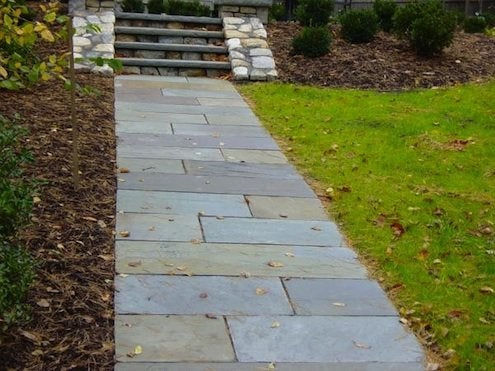Brock PaverBase: the new and better way to build your paver patio or path. Available at The Home Depot, Lowe’s and Menards.
How to Build a Stone Walkway in 14 Easy Steps Simple Instructions Designed for DIY'ers.

- Jason Cameron shares important tips on how to install a new paver walkway.
- Installing a brick walkway is easy and can add beauty to your outdoor living. There are many different types and colors of.
How To Install Pavers - a step by step concrete paver installation guide. An important part of any successful landscaping project is choosing the. Pavers are available in a variety of colors, shapes and. Tumbled pavers, with their rough edges, have an appearance similar to stone. Bush hammered or shot- blasted pavers feature a rough, stone- like finish. Ground pavers are smooth and made to look like granite, marble, terrazzo.

When installing an interlocking concrete- paver system, 9. In fact, you will do most of.
Remember that pavers offer you a great opportunity to be. Sketch a mosaic pattern on the graph paper, or try accenting a. Use the level and a 2 x 4 to check for the correct slope. For proper. drainage, the pavers should slope at a rate of 1 inch for every 5 to 8. After deciding on a shape, outline 5 to 8 inches outside the pavement.
The extra inches allow for adequate working space. Once you determine the size and shape of the project, it's time to decide.
When working on a project without many curves. If you. have a lot of curves or a paver border, add 1. Step 2: Excavating. Keeping in mind the needed slope, now is the time to decide the finished. After checking to make sure the board is level, mark the stake at. Run strings, tied to the stakes, across the length of the site to.
To lay an adequate amount of crushed aggregate stone base, bedding sand and. Remove any standing water. Any bump or depression at this or any level. If the soil is clay, place a geotextile layer over the exposed soil and up. This will provide additional stability for. The climate and type of soil under the. Cold regions with fine clay or.
If any areas need. Lay the base far enough past. For. best results, work the compactor in a circular motion and go over all areas. If the base is dry, moisten it with a garden hose (but. Without. edge restraints, pavers can shift, and the base can erode. Restraints can. be made of steel, aluminum, precast concrete or plastic. Secure plastic or.
For projects with. Floor Plan 3D V11 Activation Code. For this layer, use coarse sand, such as the kind used to make. Don't use limestone screenings or stone dust. When screeded. smooth, the sand should be no thicker than 1. For smaller projects, drag a screed board with a 2- inch notch along the.
For larger projects, lay 1- inch- diameter pipes on the base and screed the. Work in small areas by screeding the sand in 5. To keep. pavers in line, you can use the height string as a guide for the pattern of. You may need to pull out and set additional strings to mark. Gently fit pavers tightly together in the appropriate laying pattern.
When necessary along the edges, cut the pavers with a. Lay all whole pavers. Also, always wear safety glasses. After you set all pavers, use the plate compactor again to vibrate and set. For the final. step, sweep sand into the joints of the new patio, driveway or path, and. You can use the same coarse sand used for. Cop The Recruit Ds Crack here.
But be careful. what type of sand you use- -sand that is too fine will not provide for. Make sure any sand you use is completely dry so that. A job well done. The finished product is not only aesthetically pleasing but the.
They are a. cost- effective alternative to other types of paving materials. Smith is the director of the Interlocking Concrete Pavement.
Institute (Sterling, Va.).
Walkways. If you own a home and have a yard, your outdoor space probably includes some sort of path - - from front sidewalk to front door, around the side of the house, or out to the backyard. You can rely on a basic from- here- to- there walkway, or you can upgrade yours with ideas that are beautiful and practical. The first step is to choose your material - - one that complements your house and landscape design.
The options are varied: brick, gravel, cut stone, or flagstone, for example. If brick is your choice, you'll want to find a style and pattern that's a good fit for your home and garden; wander through our gallery of ideas. Shape, texture, and design are factors in every pathway, no matter the material. Look to our galleries for more inspiration on cut stone, flagstone, gravel, mixed materials, and stepping- stones.
If you want to install the path yourself, you can get it finished in a weekend or less with our step- by- step guide to a flagstone, gravel, or paver walkway. If you're really into DIY, you might want to take a look at casting your own stone steps; they're pretty and a perfect reflection of a can- do personality.